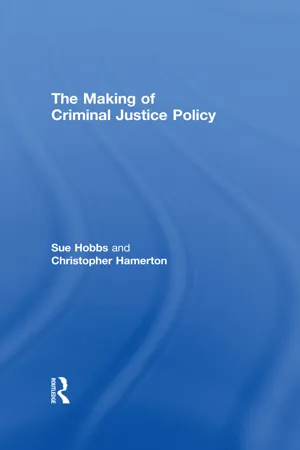
- 186 pages
- English
- ePUB (mobile friendly)
- Available on iOS & Android
The Making of Criminal Justice Policy
About this book
This new textbook will provide students of criminology with a better understanding of criminal justice policy and, in doing so, offers a framework for analysing the social, economic and political processes that shape its creation. The book adopts a policy-oriented approach to criminal justice, connecting the study of criminology to the wider study of British government, public administration and politics.
Throughout the book the focus is on key debates and competing perspectives on how policy decisions are made. Recognising that contemporary criminal justice policymakers operate in a highly politicised, public arena under the gaze of an ever-increasing variety of groups, organisations and individuals who have a stake in a particular policy issue, the book explores how and why these people seek to influence policymaking. It also recognises that criminal policy differs from other areas of public policy, as policy decisions affect the liberty and freedoms of citizens. Throughout, key ideas and debates are linked to wider sociology, criminology and social policy theory.
Key features include:
- a foreword by Tim Newburn, leading criminologist and author of Criminology (2nd Edition, 2013),
- a critical and informed analysis of the concepts, ideas and institutional practices that shape criminal justice policy making,
- an exploration of the relationship between criminal justice and wider social policy,
- a critical analysis of the debate about how and why behaviour becomes defined as requiring a criminal justice solution,
- a range of case studies, tasks, seminar questions and suggested further readings to keep the student engaged.
This text is perfect for students taking modules in criminology; criminal justice; and social and public policy, as well as those taking courses on criminal and administrative law.
Frequently asked questions
- Essential is ideal for learners and professionals who enjoy exploring a wide range of subjects. Access the Essential Library with 800,000+ trusted titles and best-sellers across business, personal growth, and the humanities. Includes unlimited reading time and Standard Read Aloud voice.
- Complete: Perfect for advanced learners and researchers needing full, unrestricted access. Unlock 1.4M+ books across hundreds of subjects, including academic and specialized titles. The Complete Plan also includes advanced features like Premium Read Aloud and Research Assistant.
Please note we cannot support devices running on iOS 13 and Android 7 or earlier. Learn more about using the app.
Information
1
Introduction
Who has a stake in criminal justice policy-making?
The insider/outsider pressure group thesis
Typology of stakeholders
Table of contents
- Cover
- Title
- Copyright
- Contents
- Notes on authors
- Foreword
- Acknowledgements
- List of abbreviations
- 1 Introduction
- 2 Social change and criminal justice policy-making
- 3 Criminal justice and social policy
- 4 The criminal justice policy-making process – the formal and informal process
- 5 The expert and research-led criminal justice policy-making
- 6 The rise of the public voice, the victims’ movement and the mass media
- 7 International influences on criminal justice policy-making
- Glossary of key terms
- Index